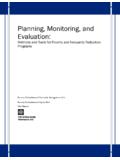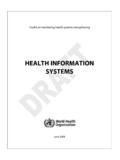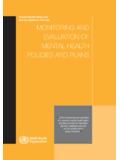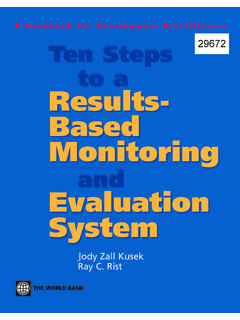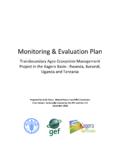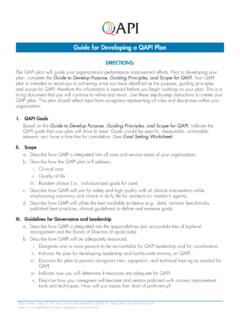Transcription of Building Results-Based Monitoring and Evaluation …
1 Evaluationen in der EntwicklungszusammenarbeitBeitr ge von der SEVAL Jahrestagung 2002 in BernBuilding Results-Based Monitoring andEvaluation Systems: assessing DevelopingCountries ReadinessJody Zall Kusek, Ray C. Rist, The World Bank, Washington, DC1. IntroductionDeveloping countries across the globe are facing pressures to reform the policiesand practices of their public Indeed, it is now widely recognized and ac-cepted that an effective and efficient public sector is a pre-requisite to achieving thedesired results of economic growth, social development, and poverty institutions do matter to the overall well being of a country (World Bank1999).
2 One means of addressing the accountability of the government to its citizensis by providing evidence on the results (or not) of the government in meeting pro-mised goals and objectives. Likewise, focusing on results can become an effectivetool of public management through better resource decision-making, monitoringwhether public initiatives are producing anticipated outcomes and impacts, and hol-ding public servants accountable for their efforts (Hatry 1999:5).As governments in general, and developing countries in particular, begin toaddress the challenges of working within a results based orientation, they face thenecessity of being able to document their performance with credible and trustwor-thy information.
3 Moving towards a results based approach to public sector mana-gement thus creates a number of requirements for the introduction of what are es-sentially expanded (if not new) information systems that go beyond the traditionalreporting on inputs, activities, and outputs to now include outcomes and a system that produces information on the results of government acti-ons and policies is a profoundly political act (Kettl 2000:37). Bringing results-basedinformation into the public arena can change many dynamics of institutional rela-tions, budgeting and resource allocations, personal political agendas, and publicperceptions of governmental effectiveness.
4 Consequently, it is not too bold a state-ment to say that moving to a results based approach to public sector managementand accountability can be an act of political courage. It can also be an act of politi-cal survival when citizen pressures for good governance and reform of corrupt go- 1 The views expressed here are those of the authors and no endorsement by the World BankGroup is intended or should be f r Evaluation Heft 1/2002: 151-158vernments reach a critical mass.
5 But either way, moving to an emphasis in the go-vernment on performance and the document of results will not happen withoutstrong political there is the technical component to be considered in introducing these sy-stems as well. Designing and Building a reporting system that can produce trust-worthy, timely, and relevant information on the performance of government pro-jects, programs, and policies requires experience, skill, and real institutional capa-city. This capacity for a Results-Based reporting system has to include, at a mini-mum: the ability to successfully construct indicators; collect, aggregate, analyze,and report on performance data vis-a-vis the indicators and their baselines.
6 And theskill and understanding to know what to do with the information once it arrives inthe hands of the intended , there also needs to be the capacity to move the resultant informa-tion both vertically and horizontally within the government and to share it in a ti-mely fashion with the parliament, civil society, and the public. Building the capacityin governments for such information systems is a long term effort consider the ef-forts in many countries to develop their census bureaus or their health and educati-on statistical systems.
7 And if such requirements are difficult in developed countries(as we have learned from many OECD examples), so much more are the difficultiesfor developing with the task seemingly monumental and the resources limited, where is adeveloping country to begin in designing and Building a Results-Based M&E systemto support continued assessment of whether or not goals are being achieved? Wehave proposed the use of a readiness assessment diagnostic instrument to helpcountries gain an understanding of what institutional capacity they do or do nothave, what resources they can draw on to initiate this effort, where within their go-vernment they might begin under the auspices of one or more political champions,and what demand (if any) exists for the use of such information.
8 Elsewhere, wehave described the rationale in depth for the use of such a diagnostic instrument asessential prior to any efforts at moving to construct an M&E system (Kusek andRist 2000, 2001).2. The Monitoring and Evaluation Readiness Assessment ToolThis assessment tool focuses on the current capacity of a government to design,build and sustain a Results-Based M&E system . It is divided into three sections: In-centives; Roles and Responsibilities; and Capacity Building . There are 40 questi-ons in the instrument that cluster into eight areas:1) Are there champions for Results-Based M&E evident within the country?
9 2) What proposed/existing government reforms are underway or planned to whicha Results-Based M&E initiative might be linked?3) Where and by whom is Results-Based M&E information used to assess govern-ment s performance?4) What management framework exist within the government to oversee the intro-duction and continuation of a Results-Based M&E system ? Kusek, Rist: Building Results-Based Monitoring and Evaluation Systems 1535) Are there any evident links between budget/resource allocation procedures andM&E information?
10 6) Who regularly collects and analyzes Results-Based M&E information to assessgovernment s performance? (inside or outside the government)7) Where does capacity exist to support a Results-Based M&E in such fields as so-cial science, Evaluation , data management, public management?8) Are there proposed or existing donor initiatives to which a Results-Based M&Einitiative might be linked?The readiness assessment diagnostic seeks to assist individual governments, the do-nor community, and their multiple development partners also involved in publicsector reform to systematically address the pre-requisites (present or not) for a re-sults-based M&E system .
